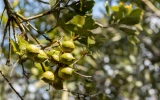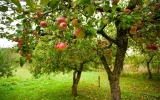How Many Pistachio Trees Should You Plant Per Acre?
Pistachio trees require ample space to grow and develop properly. However, the number of pistachio trees to plant per acre depends on several factors, including the variety you're planting, the climate in your area, and the size of your orchard. In this article, we will navigate these essential factors and uncover the ideal balance for pistachio tree planting density.
You can plant approximately 108–145 pistachio trees per acre if the spacing is 15–20 feet between each tree and 20–24 feet between each row. The Kerman variety requires around 100 trees per acre, while fewer trees are required for the Peters variety.
The climate is another important factor when deciding how many pistachio trees to plant per acre. Pistachio trees thrive in hot, dry climates, so if you live in an area with cooler temperatures or higher humidity, you may need to plant fewer trees per acre. Let's further explore how the climate in your area affects the planting density of pistachios.
Summary
- The Lost Hills pistachio variety is known for its high tree density requirement (90 to 110 trees per acre), which allows for better utilization of available land and water, leading to higher yields of high-quality nuts.
- The Golden Hills pistachio variety requires the highest tree density (100 to 120 trees per acre), reflecting its need for efficient land utilization while ensuring adequate space for tree growth and access to essential nutrients.
- In areas with cold climates, such as parts of Iran and Afghanistan, a lower tree density of 60–100 trees per acre is advised to protect the trees from harsh winter conditions and support optimal growth and production.
- In arid, hot climates such as parts of California and Arizona, a tree density of 100–150 pistachio trees per acre is recommended, as pistachio trees thrive best in intense heat and low moisture conditions.
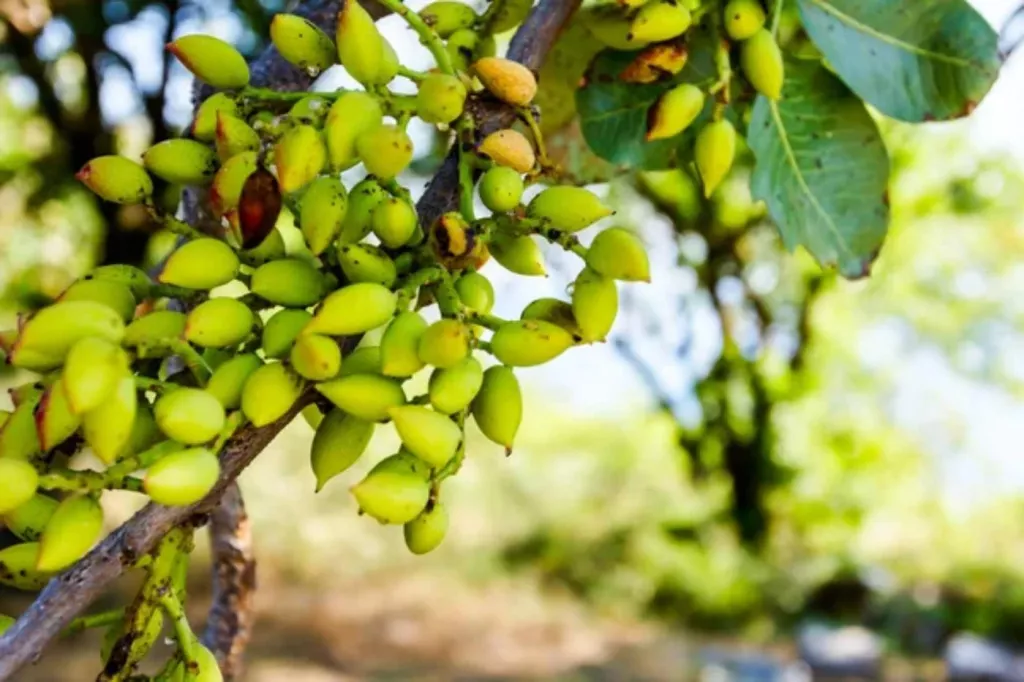
On this page:
Optimal Tree Density Based on Pistachio Variety
Different pistachio varieties exhibit varying growth habits, canopy sizes, and vigor, all of which impact the recommended spacing between trees. The table below shows the estimated tree density per acre for different varieties of pistachios:
| Pistachio Variety | Estimated Density per Acre |
|---|---|
| Kerman | 100 trees |
| Peters | 80-100 trees |
| Golden Hills | 100-120 trees |
| Lost Hills | 90-110 trees |
Tree density for Kerman pistachios
Kerman pistachio trees are typically planted at a density of 100 trees per acre. This variety is known for its large, flavorful nuts and is widely cultivated in regions with a suitable climate for pistachio production. Pistachio nuts can easily be profitable, selling for about $5–$6 per pound.
Kerman pistachio trees are known for their vigor and strong growth habit, which contributes to their ability to produce abundant yields when cultivated in suitable growing conditions.
In terms of cultivation, they thrive in regions with a Mediterranean climate, characterized by hot, dry summers and mild winters. These trees require well-drained soil and are often grown in areas where ample sunlight and proper irrigation can be provided.
Additionally, Kerman pistachios are known for their relatively high level of salt tolerance, which can be advantageous in certain growing environments.
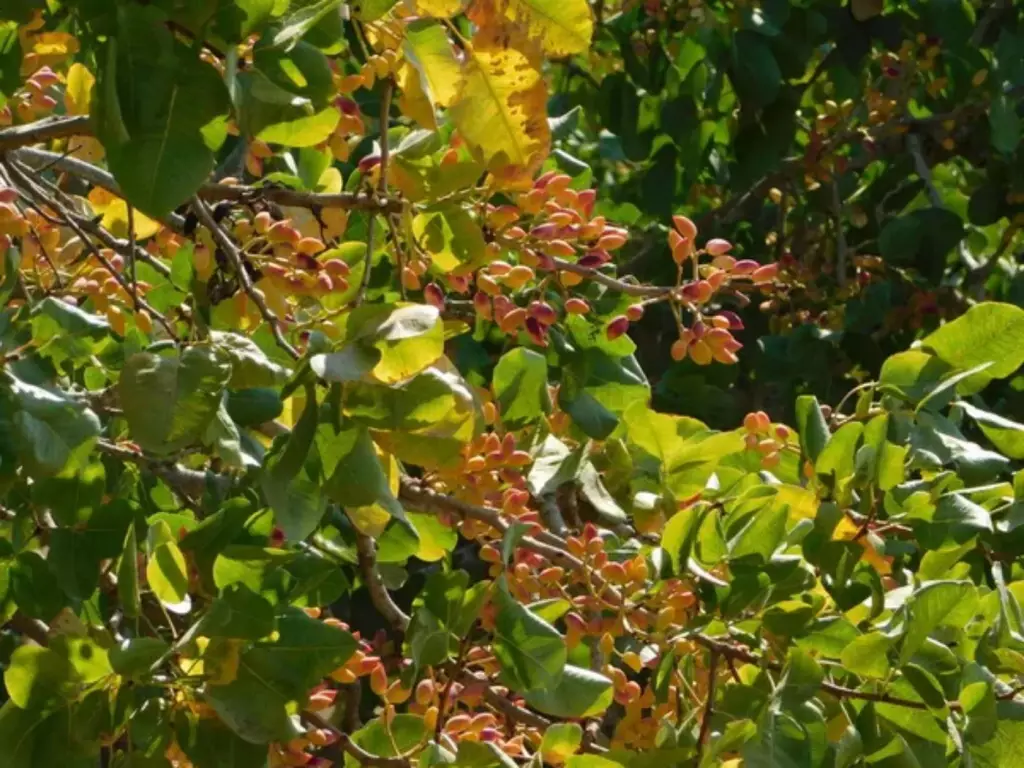
Due to their favorable characteristics, Kerman pistachios are widely cultivated in key pistachio-producing regions, such as California in the United States and other areas with similar climatic conditions.
Tree density for Peters pistachios
Peters pistachio trees are usually planted at a density ranging from 80 to 100 trees per acre. This variety is valued for its high yields and is often favored by growers for its adaptability to various growing conditions.
This variety of pistachio trees is recognized for their vigorous growth and ability to produce abundant yields even when planted at slightly lower densities compared to some other varieties.
This characteristic allows growers to achieve optimal productivity while spacing the trees at a moderate density, thereby providing a balance between efficient land utilization and maximizing yields.
Peters pistachio trees have also demonstrated resilience and productivity in diverse soil types and climate conditions, allowing growers to effectively manage orchard density based on the specific characteristics of their growing environment.
Furthermore, the lower density requirement for Peters pistachios may also be influenced by the variety's growth habits and canopy development.
By allowing slightly more space between trees, growers can facilitate healthy canopy development, light penetration, and airflow within the orchard, which can contribute to overall tree health and nut quality.
Tree density for Golden Hills pistachios
Golden Hills pistachio trees are commonly planted at a density of 100 to 120 trees per acre. This variety is prized for its large, elongated nuts and is cultivated in regions where the climate and soil conditions are conducive to pistachio cultivation.
The decision to plant them at a density of 100 to 120 trees per acre is strategic as it allows for efficient land utilization while ensuring that each tree has adequate space to grow to access essential nutrients.
Additionally, it facilitates effective irrigation and management practices, contributing to the overall health and productivity of the pistachio orchard.
The specific tree density reflects a balance between maximizing yield and maintaining the well-being of the trees, ultimately leading to the high-quality pistachios for which Golden Hills is renowned.
Tree density for Lost Hills pistachios
Lost Hills pistachios are renowned for their high density per acre, with typically 90 to 110 trees being planted in a given area. This variety is celebrated for its exceptional nut quality and is cultivated in regions known for their ideal conditions for pistachio production.
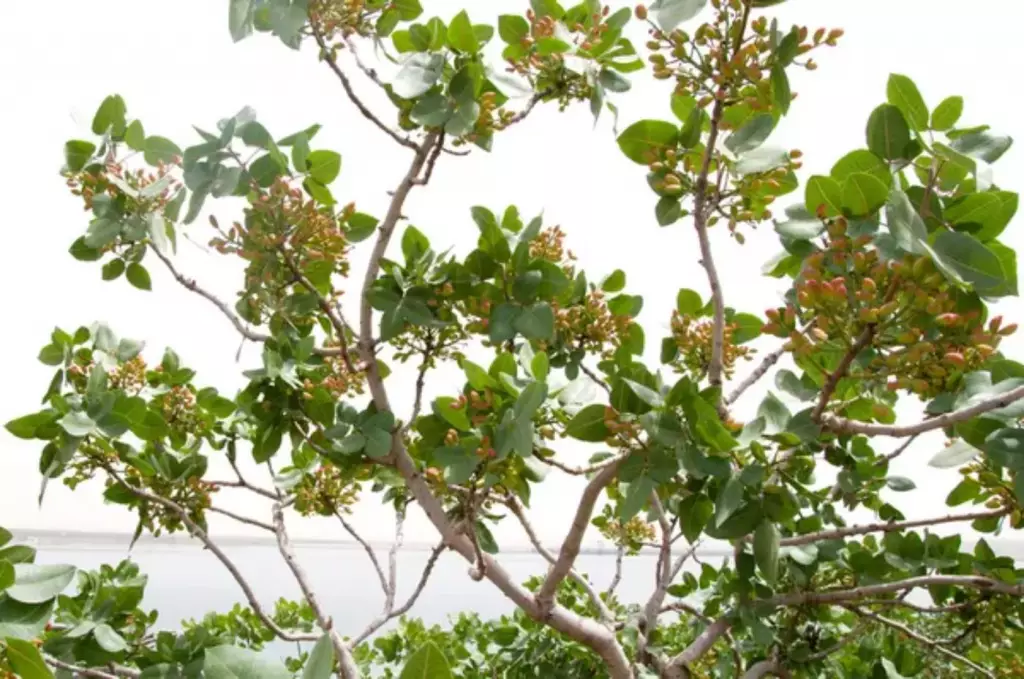
The close spacing of the trees allows for better utilization of available land and water, leading to higher yields of high-quality nuts.
Additionally, the high-density planting helps to create a microclimate that is conducive to pistachio production, promoting optimal growth and development of the trees. Pistachios are known to be fast-growers, with a quick return on investment.
Lost Hills pistachio trees are also known for their exceptional characteristics, including their ability to thrive in suitable growing regions.
Ideal Tree Density for Pistachios Based on Climate
The table below outlines the ideal tree density for pistachio cultivation based on varying climate conditions:
| Climate Conditions | Recommended Number of Pistachio Trees per Acre | Region |
|---|---|---|
| Arid, hot climate | 100-150 trees | Desert regions, such as parts of California and Arizona |
| Moderate climate | 80-120 trees | Mediterranean climates, including regions in Greece and Turkey |
| Cold climate | 60-100 trees | Regions with cold winters, such as parts of Iran and Afghanistan |
Optimal number of pistachio trees per acre in areas with arid climate
Pistachio trees are well-suited to desert regions with arid, hot climates such as parts of California and Arizona because they thrive in intense heat and low moisture conditions.
The requirement of 100-150 trees per acre in such regions is based on the specific needs of pistachio trees to ensure optimal growth and yield in these challenging environmental conditions.
This planting density allows for efficient use of available resources such as water and sunlight, while also maximizing the overall productivity of the orchard.
The higher tree density in these regions is suitable due to the tree's ability to withstand the arid environment and produce well under these conditions.
Optimal number of pistachio trees per acre in areas with moderate climate
In areas with a moderate climate, such as Mediterranean regions in Greece and Turkey, the optimal number of pistachio trees per acre ranges from 80 to 120.
This moderate climate provides a balance of heat and moisture, creating favorable conditions for pistachio tree growth. The slightly lower tree density compared to arid, hot climates is reflective of the optimal conditions in these regions, which support healthy tree growth and yield.
This planting density is carefully chosen to ensure that the pistachio trees have sufficient space and resources to thrive in the specific environmental conditions of moderate climates, ultimately contributing to a successful and productive orchard.
Optimal number of pistachio trees per acre in areas with cold climate
The optimal number of pistachio trees per acre in areas with cold climates, such as parts of Iran and Afghanistan, is recommended to be 60-100 trees per acre.
This lower tree density is advised due to the pistachio tree's sensitivity to cold temperatures. The reduced density helps protect the trees from harsh winter conditions, allowing for optimal growth and production despite the colder climate.
This approach ensures that the pistachio trees can thrive and yield a good harvest even in regions with cold winters.
Pistachio Tree Density Based on the Size of Orchard
While pistachio trees are considered one the most profitable orchard crops, the profit is still determined by the number of pistachio trees you can plant depending on your orchard size:
| Orchard Size | Number of Pistachio Trees per Acre |
|---|---|
| Small | 100-150 |
| Medium | 150-200 |
| Large | 200-250 |
Required number of trees for a small pistachio orchard
The required number of trees for a small pistachio orchard is typically 100-150 trees per acre. Small orchards are ideal for growers who are new to pistachio cultivation or have limited space for farming.
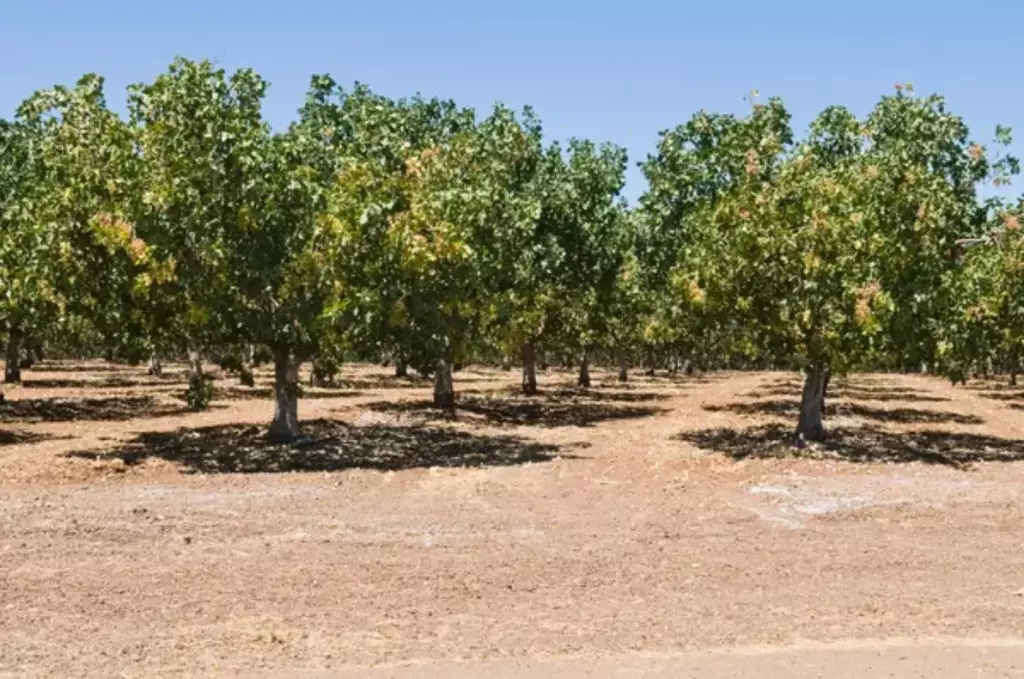
The smaller number of trees enables growers to provide more focused attention to each tree, resulting in better care and maintenance.
This spacing allows for adequate sunlight exposure and air circulation around each tree, promoting healthy growth and reducing the risk of diseases.
Additionally, the lower tree density enables growers to provide individualized care and maintenance to each tree, leading to better pest management, irrigation, and overall health of the orchard.
This spacing also facilitates efficient harvesting and maintenance activities, making it suitable for growers who are just starting out or have limited space for cultivation.
Required number of trees for a medium-sized pistachio orchard
A medium-sized orchard usually contains 150-200 pistachio trees per acre. This spacing allows for a balance between efficient space utilization and the potential for increased yield.
With a slightly higher tree density compared to small orchards, medium-sized orchards can benefit from economies of scale while still maintaining manageable operations.
Additionally, growers with medium-sized orchards typically have more experience and resources to effectively manage a slightly larger operation, allowing for increased production while still maintaining a manageable scale.
This spacing also facilitates efficient harvesting and maintenance activities, making it suitable for growers with a slightly larger operation.
Required number of trees for a large pistachio orchard
Large orchards are characterized by 200-250 pistachio trees per acre. With a larger number of trees, these operations can benefit from efficient space utilization and increased overall yield.
However, such high-density planting requires significant resources, including labor, equipment, and capital, as well as careful planning and management to ensure optimal productivity and quality.
This spacing also allows for efficient harvesting and maintenance activities, albeit requiring more intensive management and resources.
Factors Influencing Pistachio Tree Density
When deciding on the number of pistachio trees to plant per acre, there are several factors that you need to consider such as the following:
Soil and climate conditions
Pistachio trees grow best in well-drained soil with a pH range of 7.0 to 8.0. The soil should also be deep enough to allow for good root development.
In addition, pistachio trees require a hot, dry climate to thrive. They are sensitive to frost and require a certain number of winter chilling hours to fruit properly.
Nutrient requirements
Pistachio trees have specific nutrient requirements that must be met for optimal growth and yield, such as nitrogen, phosphorus, potassium, calcium, and magnesium.
The amount of nutrients required varies depending on the age of the tree and the soil conditions. A soil test can help determine the nutrient content of the soil and the amount of fertilizer needed.
Rootstock and scion combination
The choice of rootstock and scion combination can influence tree size and vigor, which in turn affects the optimal tree density. For instance, certain combinations may result in smaller, less vigorous trees, allowing for a higher density of trees per acre.
Conversely, other combinations may lead to larger, more vigorous trees, necessitating a lower tree density in order to optimize growth and yield.
Orchard management practice
Pruning, training, and other management practices can affect the shape and size of the trees, which will impact the recommended tree density.
Proper pruning and training can help control the size and shape of the trees, allowing for a higher density of trees per acre. Conversely, inadequate or improper management practices may result in larger, less controlled trees, necessitating a lower tree density to optimize growth and yield.
Pollination requirements
Consideration of the pollination requirements of pistachio trees, including the need for compatible pollinizers, can influence the arrangement and density of trees within the orchard.
Pistachio trees are not self-pollinating, so they require compatible pollinizers in close proximity to ensure successful pollination and fruit production. This means that the selection and placement of pollinizer trees within the orchard helps support the pollination process.
By understanding and addressing these pollination requirements, orchard managers can optimize the arrangement and density of trees to maximize fruit yield and quality.
Mechanical harvesting
If mechanical harvesting is utilized, the spacing and arrangement of trees may be adjusted to accommodate machinery and facilitate efficient harvest operations.
Depending on the specific requirements of the mechanical harvesting equipment, orchard managers may need to reevaluate and potentially modify the tree density per acre to ensure that the machinery can maneuver effectively while still maintaining an optimal balance for tree health and productivity.
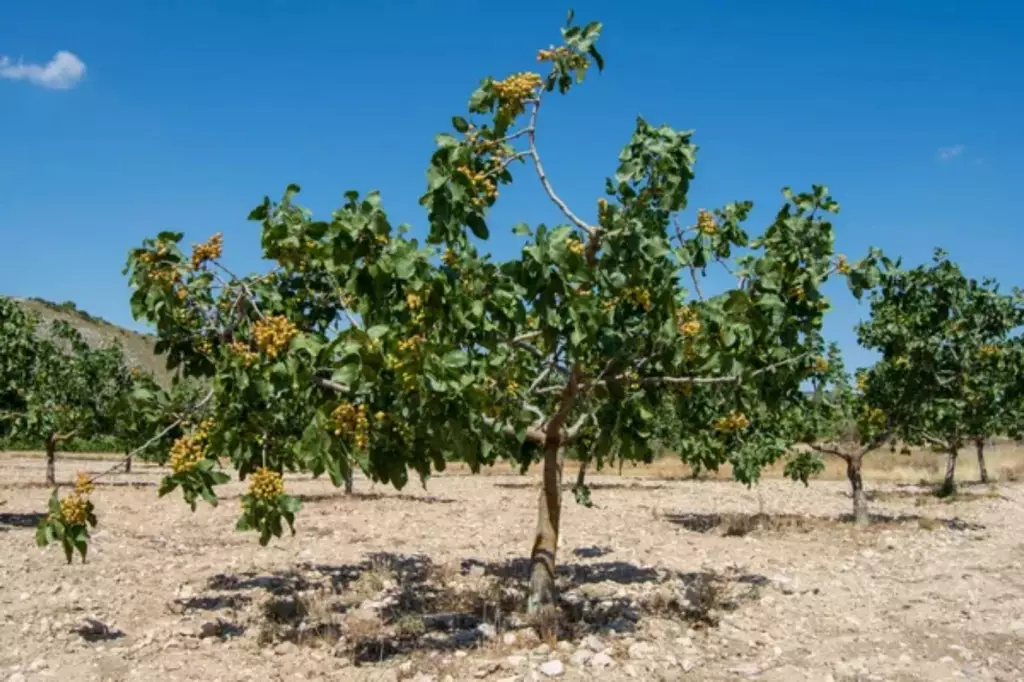
Pest and disease management
To optimize orchard health and facilitate effective pest and disease management practices, it may be necessary to adjust the tree spacing.
This can help create an environment that is more conducive to pest control measures, such as improved airflow and sunlight penetration, which can in turn reduce the risk of disease outbreaks.
Therefore, you may need to consider the specific pest and disease pressures in an area when determining the optimal tree spacing to support effective pest and disease management in the orchard.
